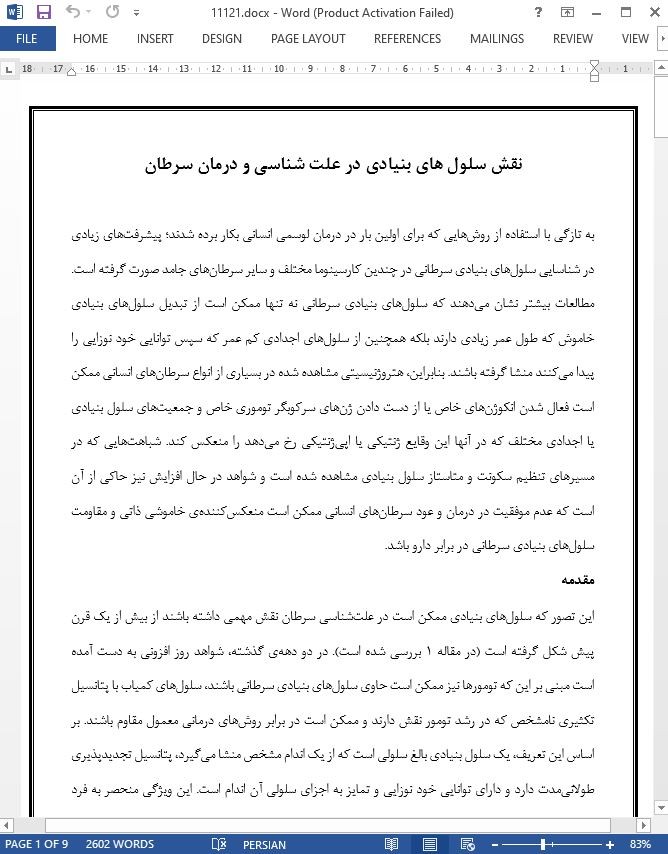
نقش سلول های بنیادی در علت شناسی و درمان سرطان
به تازگی با استفاده از روش هایی که برای اولین بار در درمان لوسمی انسانی بکار برده شدند؛ پیشرفت های زیادی در شناسایی سلول های بنیادی سرطانی در چندین کارسینوما مختلف و سایر سرطان های جامد صورت گرفته است. مطالعات بیشتر نشان می دهند که سلول های بنیادی سرطانی نه تنها ممکن است از تبدیل سلول-های بنیادی خاموش که طول عمر زیادی دارند بلکه همچنین از سلول های اجدادی کم عمر که سپس توانایی خود نوزایی را پیدا می کنند منشا گرفته باشند. بنابراین، هتروژنیسیتی مشاهده شده در بسیاری از انواع سرطان های انسانی ممکن است فعال شدن انکوژن های خاص یا از دست دادن ژن های سرکوبگر توموری خاص و جمعیتهای سلول بنیادی یا اجدادی مختلف که در آنها این وقایع ژنتیکی یا اپیژنتیکی رخ می دهد را منعکس کند. شباهت هایی که در مسیرهای تنظیم سکونت و متاستاز سلول بنیادی مشاهده شده است و شواهد در حال افزایش نیز حاکی از آن است که عدم موفقیت در درمان و عود سرطان های انسانی ممکن است منعکسکننده ی خاموشی ذاتی و مقاومت سلول های بنیادی سرطانی در برابر دارو باشد.
نتیجه گیری
با وجود انفجار اطلاعات جدید و تعداد قابل توجه نشریات در چند سال گذشته در زمینه ی "سلول بنیادی سرطانی"، هنوز هم ناشناخته های زیادی در این مورد وجود دارد. برای سلول های مختلف موجود در بیشتر بافت ها و برای تسهیل جداسازی این سلول ها به منظور شناسایی سلول های منشا زیرگروه های مختلف سرطانها، نیاز به مارکرهای بهتر رده ی سلولی و معرف های بهتر وجود دارد. در حال حاضر اطلاعات کمی در مورد ماهیت جایگاه سلول های بنیادی و مسیرهای تنظیم سکونت و خود نوزایی در سلول های بنیادی بافت طبیعی و سلول های بنیادی سرطانی در دسترس است. به طور خلاصه، اگرچه پیشرفت های اخیر دلگرم کننده هستند؛ اما تفاوت های موجود در مسیرهای سیگنالینگ در سلول های بنیادی طبیعی و سرطانی بایستی مشخص شوند تا اهداف درمانی جدیدی با هدف نهایی از بین بردن باقیمانده و عود بیماری ارائه شود.
Using approaches first applied in human leukemias, recent progress has been made in the identification of putative cancer stem cells in several different carcinomas and other solid cancers. Additional studies have suggested that cancer stem cells may be derived not only from transformation of quiescent, long-term stem cells but also from short-lived progenitors that then obtain the ability to undergo self-renewal. Therefore, the heterogeneity observed in many types of human cancers may reflect both the activation of specific oncogenes and/or loss of specific tumor suppressor genes and the different stem and/or progenitor cell populations in which these genetic or epigenetic events occur. Similarities have been observed in the pathways regulating stem cell homing and metastasis, and increasing evidence also suggests that treatment failure and the recurrence of human cancer may reflect the intrinsic quiescence and drug resistance of cancer stem cells.
Conclusions
Despite the explosion of new information and the exponential number of publications in the past few years in the ‘cancer stem cell’ field, much remains to be learned. There is a need for better cell-lineage markers for the multiple cell types present in most tissues, and for better reagents to facilitate the isolation of these cells in order to enable the identification of the cells of origin for the different subtypes of cancers. Little information is currently available about the nature of the stem cell niche and the pathways regulating quiescence and self-renewal in both normal tissue stem cells and cancer stem cells. In summary, although recent progress has been encouraging, the differences in signaling pathways in normal and cancer stem cells need to be elucidated to provide new therapeutic targets with the eventual goal of eliminating residual disease and recurrence.
مقدمه
منشا سلول های بنیادی سرطانی
مقاومت دارویی در سلول های بنیادی
سلول های بنیادی سرطانی و اهمیت بالینی
نتیجه گیری
Introduction
Origin of cancer stem cells
Drug resistance in stem cells
Cancer stem cells and clinical significance
Conclusions
- اصل مقاله انگلیسی با فرمت ورد (word) با قابلیت ویرایش
- ترجمه فارسی مقاله با فرمت ورد (word) با قابلیت ویرایش، بدون آرم سایت ای ترجمه
- ترجمه فارسی مقاله با فرمت pdf، بدون آرم سایت ای ترجمه


